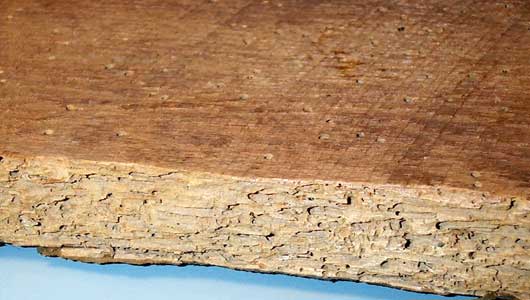Pest Control - Borer, Bora or Woodworm
Borer is also known as Bora or woodworm. There are up to 7 species of wood- boring insects in New Zealand that might attack the timbers of your home or other buildings. The most common of these is the Common House Borer (Anobium punctatum) also known as Woodworm in the UK.
Luckily, Pest Control Specialists have years of experience in Borer control in and around Napier, Hastings and throughout the Hawkes Bay and Manawatu.

Borer or Wood Worm Pest Issues:
A close relative, A lavomaculatum is rarely distinguished from the Common Borer and may be the more common in Canterbury. The life cycles of these insects are similar. Adult females lay up to 100 eggs on bare timber or in old flight holes. The eggs hatch after 4-5 weeks and the larvae bore through the wood, eating it and using yeasts in their stomachs to help break down cellulose in the wood. After 3-4 years the larvae pupate in a chamber near the surface, then 4-8 weeks later the adults exit the wood by eating their way to the surface. The adults fly to find a mate and begin the life cycle over again. The females lay their eggs on bare wood, in the case of painted weather boards this will be the flight holes created by emerging adults. The flight holes are approximately 2mm in diameter for Common Borer and 3-4mm for native borer. It is important that a thorough survey is carried out to ascertain the extent of any infestation. It is frequently the case that a few flight holes are visible on the exterior of painted weather boards, however when the boards are examined more closely the interior of the timbers are badly damaged and many flight holes are present on the interior surface.
Two-toothed longicorn (Ambeodontis tristis (Fabricus) is a much larger wood boring beetle that can be found attacking construction timbers. The flight holes are much larger, up to 7mm in diameter and often oval. The larvae of this beetle can attack harder heartwood and because of their larger labyrinths they can severely weaken structural joists and beams. Borer larvae prefer the softer sap wood timbers to eat and damage. It is often seen in weatherboards or floor boards that some are heavily attacked and others untouched. The untouched timbers are likely to be harder heartwood. It is also the case that attack is more likely on the south side of a house and in the floor boards and joists. This is because borer prefer the cooler damper areas where the relative humidity is higher.
Borer Timber Protection contol and management:
Pest control specialists provides timber protection treatments with a guarantee of protection. Treatment of timbers to remove borer infestation is the same for whichever species is present. Exposed timber can be treated with insecticides that penetrate the wood and will protect it for 10 years or more. Usually the floor timbers are attacked because of the high relative humidity in the sub-floor.
Pest Control specialists can treat these exposed timbers to eradicate the borer and protect the timbers. Weatherboard homes in New Zealand are not always pre-treated and are often infested where the softer, non-heartwood timber has been used. Weather boards are more difficult to treat as they are not usually exposed. However, weather boards can be protected by injecting the flight holes made by emerging adults. The pentrating treatment will kill larvae within the boards and prevent adults re-infesting the boards via the exposed wood of the flight holes.